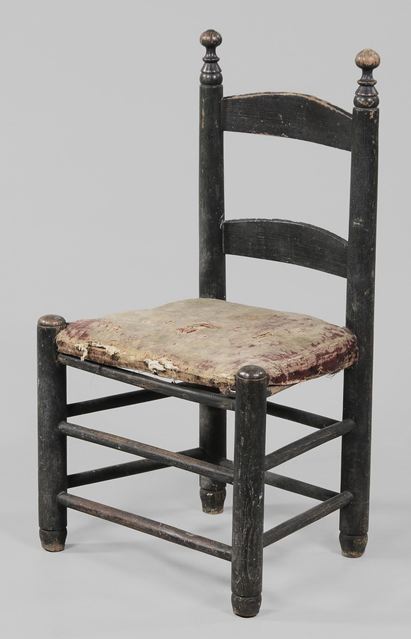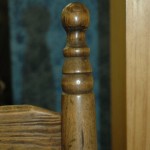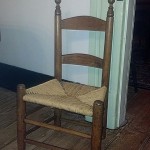By Mark R Wenger
These chairs form a distinctive and coherent group, seemingly associated with Greensville and Brunswick Counties, and possibly Lunenburg as well. Thus far, only side chairs have been noted, appearing in adult, youth, and infant sizes. There are two major subgroups, each defined by a particular version of the finial and a corresponding foot.
Eastern Subgroup
Among the chairs of this type, four were purchased in Emporia, and two more were found in a shop at Edgerton, near the Brunswick/Greensville County line. Among the Emporia chairs was a set of three, reportedly consigned by a Greensville County family with roots in Brunswick County. Perhaps, then, these chairs originated in Brunswick or Greensville County, Virginia.
Subgroup 1, illustrated above, may have originated in Greensville County and the eastern part of Brunswick. The finial is composed of a pawn-like figure atop a truncated cone and a torus, the pawn having a faintly raised button on the top. The backs exhibit two broad slats, the upper one being the widest. In all cases, they are deeply arched and broadly beveled on their top edges. Usually both slats are through-pegged from the back and they display riven surface on both faces. The rear legs taper slightly from the seat upward. Below the seat, all legs are all perfectly straight. Well-formed “biscuit” turnings terminate the tops of the front legs. Chairs of this eastern subgroup exhibit a compound foot consisting of a heavy torus seated atop a rebated cylinder. All chairs examined had eight stretchers, those in the front and rear standing lower than those on the sides. These always stand tangent to the verge lines, and in certain cases, it is clear that the holes for these members were started with a gouge. The tenons are typically shaved on the sides. (Evidently drilled mortises were extended at the top and bottom to receive these shaped tenons). Most of the chairs are made of maple, though examples of walnut and hickory have been noted. The earliest seat noted has white oak splints of varying width, all exhibiting wavy, uneven surfaces.
Three such chairs, purchased as a group in Emporia, may be the earliest, judging from their heft, and from the extent of riven surface on the legs, slats, and rounds. Rush seats have been observed, but none of these is demonstrably original. Two matted seats have been noted, which appear to be early.
A Youth-Sized Version
This youth-sized chair, purchased in Spring Hope, NC, has essentially the same finial and foot as the illustrated example above. Because there is no seat, the chair disassembles easily to illustrate the method of making the tenons and mortises of the stretchers. In this case, the chair maker started each hole with a gouge to start the bit in cutting the mortises.
An Infant-Sized Version
This infant-sized side chair was photographed at a Bedford County, Virginia antiques mall. The top slat is replaced, the feet have been cut off at the bottom stretcher, and the seat is replaced. In spite of these unfortunate alterations, the chair helps define the range of available forms in this Brunswick-Greensville design.
The final is a compressed version of those we have already seen, the truncated cone being more dramatically tapered than on the other chairs we have seen. Both slats were pegged all the way through the stiles. Despite significant damage, the original lower slat exhibits the same deep chamfering observed on the other chairs of the group.
A Later Chair
This chair represents the persistence of the Brunswick County design into the latter half of the 19th century. All the slats are nailed, rather than pegged, suggesting a post-bellum date of manufacture. In the detailing of the feet and finial, the chair resembles the eastern examples and so appears in company with that subgroup.
20th-Century Chairs
An Emporia dealer reported that an African-American artisan continued to make Brunswick-style chairs well into the 20th century.[1] Two weeks after hearing this, the author came across the chair in the left photo at Williamsburg antiques mall. Its relationship to the group was evident from across the room, and the purchase was made in great haste and excitement. Only when the chair was in the car did it become obvious that this was a 20th-century object–THIS was one of the 20th-century chairs the dealer had mentioned. The maker had not attempted to mask the late date of his product—the rounds and slats were all secured with wire nails—but the salient features of earlier chairs had been reproduced with admirable fidelity. The main differences were in the rough finishing of the slats and the exaggerated height of the feet. This late example illustrates the persistence of certain mental templates and work methods among regional chair makers. It seems likely that this chair, and others like it, were made sometime prior to World War II.
However, another example, clearly by the same artisan, retains what may be an original rush seat. This is a “bib” type installation, woven with the cords running front to back, a form typically associated with the eastern counties of NC and VA. In this case, it is clear that the earlier eastern chairs we have considered were the inspiration for this “modern” design.
Western Subgroup
A second subgroup of these chairs appears to have been associated with the western portion of Brunswick County, and perhaps with the adjoining county of Lunenburg, to the west. A resident of Lawrenceville, the county seat of Brunswick, owns an example of this form, which has been in his family as long as anyone can remember, and that family has always lived in Brunswick and Lunenburg Counties. That association is the basis for suggesting that the subgroup II originated farther west than the previous chairs.
The Lawrenceville example serves to define the attributes of the western subgroup–the ogee form of the foot (with some loss of height in this case), the “door-knob” shape of the upper finial, and the drastic taper of the truncated cone. The raised turning atop the finial tends to be smaller, but in higher relief than on the eastern chairs, though in a few cases, the turning is entirely absent.
An Important Early Seat
Illustrated below is a documented adult chair, collected in Warren County (just south of Brunswick) by a native of the area.[2] Several details distinguish this chair from the others–both slats are virtually the same height, neither is pegged through the front of the stile, and the stretchers are significantly lighter than on other chairs of the larger group. Perhaps this example was actually made in Warren County, under inspiration of the western chairs.
The early seat of this chair was badly damaged, and so has been reproduced by the present owner. For that reason, it is an important document illuminating one method of seating these chairs.
This fine chair embodies all the attributes of the westrn subgroup. It seems to retain something like the original height of the far rear foot. The installation of a mid-late 19th century seat frame and plush covering indicates that the previous seat and thus the chair must pre-date that era. The chair came to auction at Brunk’s in 2012.
Blind Pegs & A Variant Foot
On this chair, clearly belonging to the western subgroup, the pegs do not show on the fronts of the stiles. Moreover, the chair displays a variant ogee foot that seems to represent a transitional stage between the eastern and partly cylindrical western feet.
A Western-Style Infant’s Chair
In a NC collection is this infant’s chair, displaying the finial typical of western chairs. Like the eastern example examined earlier, this one has lost its feet. However, both of the slats remain, giving us a firm sense of the original design. Note that these slats are not as radically arched as on the chairs already considered, but here, as before, both are through-pegged from the rear. The rush seat appears to be a replacement.
The front faces of the legs display the intensive wear often seen on children’s chairs, supposedly a consequence of toddler’s pushing the thing about like a garden tiller as they learned to walk.
Published on: Sep 30, 2013
End Notes:
1. Personal Communication, Barbara Belmonte, Emporia, Virginia.
2. Personal communication, Hiram Perkinson. This chair was exhibited at the Blount-Bridges House, in Tarboro, NC.


































